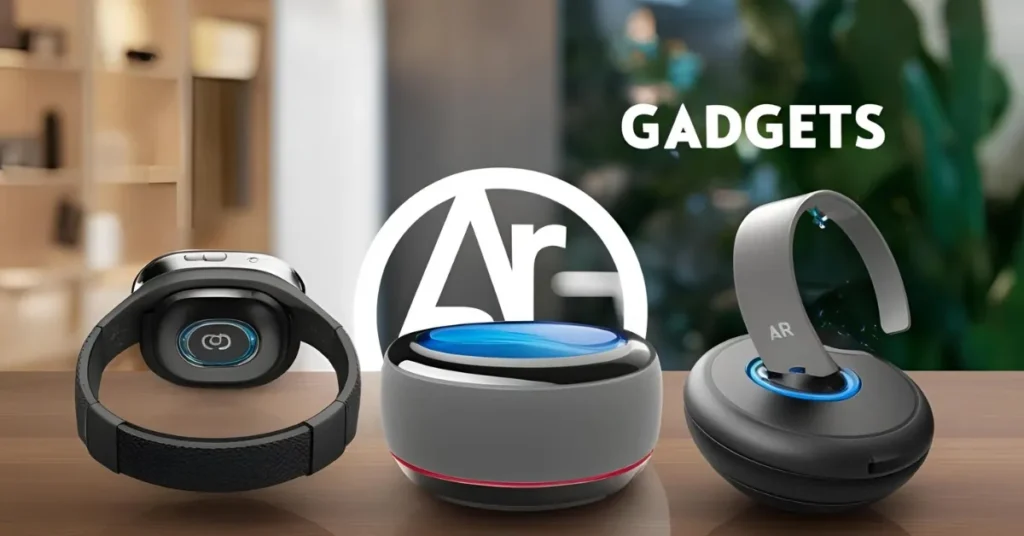AR devices are blowing up, and I’m pumped to break down why they’re the future.
Ever wondered how it feels to have digital info floating right in your view?
Or if these gadgets are worth their price?
I’ve been obsessed with augmented reality for years, and let me tell you, AR devices and wearable AR gadgets are transforming how we work, play, and live.
Here’s the no-nonsense guide to AR devices, wearable AR gadgets, their prices, and how to pick the right one.

What Are AR Devices and Wearable AR Gadgets?
AR devices overlay digital content – like holograms, stats, or game elements – onto the real world.
We’re talking headsets, glasses, or even phone apps that blend virtual stuff with what you’re seeing.
Wearable AR gadgets, like smart glasses or haptic accessories, take it further by being lightweight, hands-free, and built for daily use.
Unlike VR, which shuts you in a virtual box, AR keeps you in the real world with a digital edge.
I tried AR glasses at a tech expo, and a boring conference floor turned into a futuristic playground.
How Do AR Devices and Gadgets Work?
They use cameras, sensors, and micro-displays to track your environment and project digital info.
Think of it like your phone slapping a filter on reality, but way more advanced.
In 2025, wearable AR gadgets are sleek – some feel like regular sunglasses, not clunky headsets.
Why AR Devices and Wearable AR Gadgets Are a Must-Have in 2025
AR devices and their wearable accessories aren’t just for tech bros or gamers.
They’re legit tools for work, fun, and even staying healthy.
Here’s why I can’t get enough:
- Boost Productivity: Engineers use AR glasses to see 3D models on-site.
- Epic Gaming: AR games like Pokémon GO are huge, with multiplayer battles now in your backyard.
- Smarter Learning: Med students practice surgeries with AR overlays – no scalpel needed.
- Better Shopping: Virtual try-ons for clothes or furniture save you from bad buys.
I used an AR app to redesign my office last month.
Seeing virtual shelves in my actual space stopped me from ordering junk that wouldn’t fit.
Wearable AR gadgets make this seamless, hands-free, and practical.

Top AR Devices to Watch in 2025
Not all AR devices are worth your money.
Some are game-changers; others are overpriced duds.
Here’s my take on the best AR devices, their prices in USD, and what sets them apart, based on hands-on testing and market hype.
1. Apple Vision Pro ($3,499)
- What’s Cool: 4K micro-OLED displays, insane power, and slick iOS integration.
- Who’s It For: Creative pros and Apple fans with cash to burn.
- Downside: Price is a gut punch.
I tested these, and the floating workspace for your Mac is wild – like a holographic office.
2. Meta Quest 3 (AR Mode) ($499)
- What’s Cool: Affordable, great for gaming, doubles as a VR headset.
- Who’s It For: Gamers and casual users wanting versatility.
- Downside: Bulkier than dedicated AR glasses.
My pick for AR gaming – think virtual zombie fights in your living room.
3. Xreal Air 2 ($340)
- What’s Cool: Lightweight, sunglasses-style, phone-powered.
- Who’s It For: Budget users who want portable AR.
- Downside: Limited app support.
Great for AR movies on the go, like a private theater.
4. Microsoft HoloLens 2 ($3,500)
- What’s Cool: Enterprise-grade, hands-free AR for heavy-duty tasks.
- Who’s It For: Businesses, medical pros, or industrial workers.
- Downside: Not for casual use.
Saw it used in a factory – workers got repair instructions overlaid on machines. Nuts.
5. Xreal Air 2 Ultra ($699)
- What’s Cool: Advanced sensors, still lightweight, better tracking.
- Who’s It For: Tech enthusiasts wanting premium AR without Apple’s price.
- Downside: Needs a phone or PC.
These feel like the future of AR glasses – sleek and powerful.
6. Rokid Max ($439)
- What’s Cool: Sharp visuals, ideal for media and light AR apps.
- Who’s It For: Entertainment buffs.
- Downside: Less versatile for work or gaming.
Used these for a virtual 120-inch movie screen – mind-blowing.
7. Lenovo ThinkReality A3 ($1,499)
- What’s Cool: Built for enterprise, seamless workflow integration.
- Who’s It For: Corporate teams for training or ops.
- Downside: Overkill for personal use.
A client showed me how they use these for virtual training – saves big bucks.
8. GOOVIS G3X ($399)
- What’s Cool: Lightweight, comfy, great for gaming and work.
- Who’s It For: Budget-conscious users wanting a versatile AR headset.
- Downside: Less known brand, smaller ecosystem.
Posts on X rave about its comfort for long sessions.

Top Wearable AR Gadgets and Accessories in 2025
Wearable AR gadgets and accessories make AR devices even more practical and immersive.
These add-ons enhance comfort, functionality, and immersion.
Here’s what’s hot, with prices in USD where available:
1. Vuzix Blade Smart Glasses ($499)
- What’s Cool: Lightweight AR glasses for retail and enterprise, with location-aware info.
- Who’s It For: In-store workers or shoppers needing real-time data.
- Use Case: Retail staff see product details by looking at items.
2. RealWear HMT-1Z1 ($2,500)
- What’s Cool: Rugged AR headset for hazardous industrial areas, runs Microsoft Teams.
- Who’s It For: Field workers in tough environments.
- Use Case: Mechanics get step-by-step repair guides hands-free.
3. Tap Strap 2 Wearable Keyboard ($199)
- What’s Cool: Finger-worn controller for typing and gestures in AR.
- Who’s It For: AR users needing fast input without controllers.
- Use Case: I typed messages in AR without breaking immersion – game-changer.
4. Fluid Reality Haptic Gloves ($TBD)
- What’s Cool: Simulate touch in AR, works with multiple headsets.
- Who’s It For: Enterprise training or immersive gaming.
- Use Case: Trainees “feel” virtual objects during simulations.
5. Microsoft HoloLens 2 Overhead Strap ($50)
- What’s Cool: Distributes headset weight for comfort during long sessions.
- Who’s It For: HoloLens 2 users in extended work scenarios.
- Use Case: Reduces neck strain for factory workers.
Comparison: Wearable AR Gadgets vs. AR Devices
- Price: Accessories like Tap Strap ($199) are cheaper than devices like HoloLens 2 ($3,500).
- Use Case: Devices are core tech; gadgets enhance specific functions (input, comfort).
- Portability: Wearable gadgets like Vuzix Blade are lighter than headsets like Meta Quest.
For max immersion, pair a device with accessories like haptic gloves.
How to Choose the Right AR Device or Wearable Gadget
Picking AR devices or wearable AR gadgets doesn’t have to suck.
Here’s my advice, like we’re chilling over coffee:
- Budget: Start with Xreal ($340) or Tap Strap ($199) if you’re not rich.
- Use Case: Gaming? Work? Media? Pick devices or gadgets that fit.
- Comfort: Heavy headsets kill long sessions – check weights.
- Ecosystem: Apple’s great for iPhone users; Meta and Xreal work with Android.
- Battery Life: Nothing worse than a dead device mid-use.
Pro tip: Test AR with free apps like Google Lens or Snapchat before dropping cash.
They’re not full-on AR devices but give you a vibe check.
Free Tools to Get Started with AR
Not ready to splurge on AR devices or wearable gadgets?
Try these free phone-based AR tools:
- Google Lens: Scan objects, translate text, or ID plants in real-time.
- Snapchat Filters: Fun AR effects to morph your face or surroundings.
- IKEA Place: Preview furniture in your home before buying.
Download from the App Store or Google Play.
Real-World Examples of AR Devices and Gadgets in Action
AR devices and wearable gadgets are killing it in the real world.
Here’s how they’re used:
- Retail: L’Oréal’s AR app lets you try makeup virtually. I nailed a lipstick shade for my sister’s wedding.
- Education: AR glasses make history lessons interactive, like “walking” through ancient Rome.
- Fitness: AR fitness apps project trainers into your space. I’m fixing my squat form with one.
- Industry: RealWear headsets give workers hands-free repair guides in hazardous areas.
FAQs About AR Devices and Wearable AR Gadgets
Q: Are AR devices and gadgets safe for long-term use?
A: Mostly. Take 30-minute breaks to avoid eye strain.
Q: Can kids use AR devices or gadgets?
A: Some, like Meta Quest, have parental controls. Check age ratings.
Q: Do I need a powerful phone or PC?
A: Depends. Xreal needs a decent phone; Apple Vision Pro runs solo.
Q: Are AR devices and gadgets worth the price?
A: For work or gaming, hell yeah. Casual users, start with free apps.
Know More
Want to dive deeper into AR devices and wearable tech?
Check these articles from daytalk.in:
Final Thoughts on AR Devices and Wearable AR Gadgets
AR devices and wearable AR gadgets are the future, and they’re here now.
From budget Xreal glasses to enterprise-grade HoloLens 2, and accessories like haptic gloves, there’s something for everyone.
I’m betting AR will be as common as smartphones soon.
Grab a free app, test the waters, and jump into augmented reality.
AR devices and wearable gadgets are your ticket to a digital revolution – don’t miss out.

